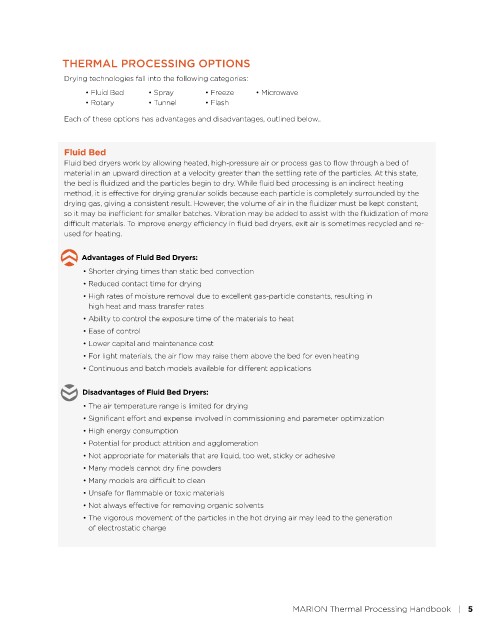Page 2707 - Flipbook_SolidDesignSoutheast2020
P. 2707
THERMAL PROCESSING OPTIONS
Drying technologies fall into the following categories:
• Fluid Bed • Spray • Freeze • Microwave
• Rotary • Tunnel • Flash
Each of these options has advantages and disadvantages, outlined below..
Fluid Bed
Fluid bed dryers work by allowing heated, high-pressure air or process gas to flow through a bed of
material in an upward direction at a velocity greater than the settling rate of the particles. At this state,
the bed is fluidized and the particles begin to dry. While fluid bed processing is an indirect heating
method, it is effective for drying granular solids because each particle is completely surrounded by the
drying gas, giving a consistent result. However, the volume of air in the fluidizer must be kept constant,
so it may be inefficient for smaller batches. Vibration may be added to assist with the fluidization of more
difficult materials. To improve energy efficiency in fluid bed dryers, exit air is sometimes recycled and re-
used for heating.
Advantages of Fluid Bed Dryers:
• Shorter drying times than static bed convection
• Reduced contact time for drying
• High rates of moisture removal due to excellent gas-particle constants, resulting in
high heat and mass transfer rates
• Ability to control the exposure time of the materials to heat
• Ease of control
• Lower capital and maintenance cost
• For light materials, the air flow may raise them above the bed for even heating
• Continuous and batch models available for different applications
Disadvantages of Fluid Bed Dryers:
• The air temperature range is limited for drying
• Significant effort and expense involved in commissioning and parameter optimization
• High energy consumption
• Potential for product attrition and agglomeration
• Not appropriate for materials that are liquid, too wet, sticky or adhesive
• Many models cannot dry fine powders
• Many models are difficult to clean
• Unsafe for flammable or toxic materials
• Not always effective for removing organic solvents
• The vigorous movement of the particles in the hot drying air may lead to the generation
of electrostatic charge
MARION Thermal Processing Handbook | 5

